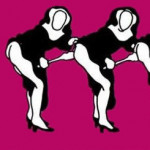“Keith Haring, Artist, Dies at 31; Career Began in Subway Graffiti” declared The New York Times in 1990. The headline underplayed the tremendous influence that the boyishly bespectacled Pennsylvania-born gay artist had had on New York City—and the world—in his brief life. In one decade, the 1980s, his distinctive babies, angels, barking dogs and half-human/half-beast figures, as playful and childlike as they were subversive and sophisticated, all drawn with the thick black line that was inimitably his, had gone from empty ad boards on the walls of New York City’s subway stations to the galleries and walls of the world.
“I don’t like to sound pretentious,” Haring said in his last interview, two weeks before he died, “but I think that in a way, some people [in the art world establishment] were insulted because I didn’t need them.... I didn’t go through any of the proper channels and succeeded in going directly to the public and finding my own audience.”

Keith HaringCourtesy of Keith Haring Foundation
And it was true. The career that garnered the artist global fame and fortune had begun on the streets of New York, among a community of graffiti artists. If the art world was marked by elitism and exclusivity, the way Haring made art—publicly, inviting others to watch and sometimes even participate, often working alongside young people in New York’s poorest neighborhoods—was the opposite.
By 1989, Haring was quite ill from AIDS, his body covered in Kaposi sarcoma lesions. (He had cosmetic surgery to remove the ones on his face.) He’d already suffered through the AIDS-related deaths of several friends and lovers, including Klaus Nomi, Bobby Breslau, Martin Burgoyne (who’d also, like Haring, been a close friend of Madonna’s) and his ex-lover Juan Dubose as well as the deaths (not AIDS-related) of two of his closest artistic associates, Andy Warhol and Jean-Michel Basquiat. He’d written in his diary: “I’m not really scared of AIDS. Not for myself. I’m scared of having to watch more people die in front of me.”
Discussing his own 1988 diagnosis, which he’d suspected several years prior, he said, “[W]hen it actually does happen, you’re not prepared. So the first thing you do is break down. I went over the East River on the Lower East Side and just cried and cried and cried. But then you have to get yourself together and you have to go on. You realize it’s not the end right then and there—that you’ve got to continue, and you’ve got to figure out how you’re going to deal with it.”
Haring did just that in his final years, making a frenzy of (often death-invoking) work both in New York and abroad, despite his disgust that his impending death would almost certainly make the value of his work skyrocket. He also came out publicly as a person living with AIDS in a 1989 Rolling Stone interview and became involved with ACT UP New York, the AIDS activist group whose influence gained incredible momentum in the final years of the ’80s. Not only did Haring write a fundraising letter for the group that netted $70,000, but he also made a $10,000 donation, designed a poster for the group, paid for buses to take activists to AIDS conferences and donated artwork for the group’s first major fundraiser, an art auction cochaired by David Hockney and Annie Leibovitz.

Keith Haring’s Ignorance = Fear / Silence = Death, 1989
In his final months, Haring painted often from a “secret” studio with a special resting/sleeping area that his friends had set up so that he could work in maximum peace and comfort. Among the body of work he produced in those days is his iconic Unfinished Painting, which features his signature hieroglyphic lines in the canvas’s upper left corner, with paint from that area dripping down onto an otherwise hauntingly empty canvas.
In his final hours, Haring—in a beautifully designed Greenwich Village townhouse he’d moved into only months before—was surrounded by those closest to him, including the artists Kenny Scharf and Francesco Clemente and their families. (Haring loved kids, and kids loved Haring.) Madonna, away on her Blonde Ambition tour, was the last person to talk to him by phone. He died with his parents—with whom he had remained very close but had never told directly he was gay or had AIDS—holding him in bed.
His memorial service was held on what would have been his 32nd birthday, at the Cathedral of St. John the Divine, where choreographer Alvin Ailey, who’d died of AIDS complications only a few months before, had also been memorialized. The opera soprano Jessye Norman sang and New York City Mayor David Dinkins, who attended, said of Haring, “his short life was a mission. It is said that service to others is the rent we pay for space on Earth. Keith left us paid in full.”
The memorial program included a quote from his Rolling Stone interview: “Part of the reason that I’m not having trouble facing the reality of death is that it’s not a limitation, in a way...everything I’m doing right now is exactly what I want to do.”

The Keith Haring Barbie next to a mural by artist Tysen Knight on a street bench in downtown Palm Springs, California.POZ / Jennifer Morton
Shortly before he died, Haring formed a foundation in his name that currently has assets of $60 million and has given away $43 million in gifts, many to HIV- and LGBTQ-related causes and groups. His work is in the collections of more than 60 museums worldwide, and such contemporary brands as Uniqlo have introduced his work to a new generation of fans via reproductions on clothing and other products.
For more on Keith Haring’s life and art, read Radiant: The Life and Line of Keith Haring by Brad Gooch, available in March 2024.







Comments
Comments